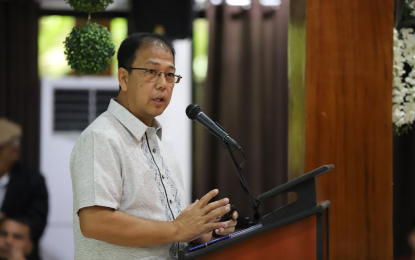
Presidential Peace Adviser and chief implementer of the National Action Plan against coronavirus Carlito G. Galvez Jr. (OPAPP photo)
MANILA – The National Task Force (NTF) created by the Duterte Administration to battle the coronavirus disease (Covid-19) pandemic is anchored on the “detect-isolate-treat” operational methodology, Presidential Peace Adviser Carlito Galvez Jr. said on Wednesday.
“An infected person becomes a threat to the general public when he or she is mobile and not isolated, and becomes a carrier of the disease,” said Galvez, a designated chief implementer of the National Action Plan (NAP) against Covid-19.
Galvez said the NTF has adopted a “carrier-centric” approach which aims to detect, isolate and treat Covid-19 patients so they can be cured of the disease and return to their communities as soon as possible.
“There is a need to determine the social impact of these mitigation measures, as interventions shall be implemented by line agencies at the national level and local government units at the community level throughout the critical stages of this campaign,” he said.
Galvez said the measures shall be implemented under the NTF’s unified structure, composed of the Task Groups on Response Operations, Resource Management and Logistics, and Strategic communication.
The task groups, he said, shall receive guidance from the Inter-Agency Task Force for the Management of Emerging and Infection Diseases (IATF-EID), the policy-making body of the NTF co-chaired by Health Secretary Francisco Duque III, Environment Secretary Roy Cimatu, and Cabinet Secretary Karlo Nograles.
To detect potential Covid-19 carriers, Galvez said it is imperative to do massive testing of patients under investigation (PUIs) and persons under monitoring (PUMs) without delay, effective contact tracing, enforce enhanced community/home quarantine, and isolate patients who are considered PUIs.
“Contact-tracing will be crucial in this effort, as it will enable us to quickly and effectively identify the potential carriers of the disease, and isolate them from the rest of the community before they can infect others. We can use the existing technology, transparency of government processes and vigilance of the community," he said.
"LGUs should find innovative ways by combining the strategy of selective and total lockdown, massive testing, designation of appropriate ‘forced quarantine’ facilities for PUIs and PUMs, effective implementation of social distancing and home quarantine and protection and segregation of the seniors, vulnerable sector and urban poor," he added.
Galvez said in isolating disease carriers, they need to designate government-dedicated treatment facilities for Covid-19, while PUIs need to be taken to converted isolation centers for closer monitoring.
“Once these Covid-19 patients receive the treatment they need and are able to fully recuperate from the disease, they can be discharged from the facilities and can now return to mainstream society, but still should remain self-aware,” he said.
“Through this approach, we hope to get a bigger picture of the geographic affectation, the number of Covid-19 patients, the current number of facilities which are available, and the resources needed for this massive, nationwide effort,” Galvez said.
He, however, said the NTF’s concept of operations “is not a military solution as some describe it but rather a medical solution wherein our goal is to provide life-saving health services to people as quickly and efficiently as possible, since in reality, logistics and capacity will dominate the healthcare response when the virus becomes more widespread and the number of Covid-19 patients exponentially increase.”
“Based on the timetable given to us by the President, we hope to take out all Covid-19 positive patients and PUIs from their communities by April 14,” Galvez said, adding this move will help reduce the public’s anxiety over the spread of the disease.
He said once these interventions are effectively carried out, evaluations will be done at the sitio and barangay level starting April 15.
These evaluations, Galvez said, shall become the basis for declaring communities as “cleared” from the disease, adding "the systems thinking analysis of our pandemic experts coming from the academe and the medical community are also vital."
“Our long-term objective here is to see the gradual normalization of communities who have been severely affected by this health crisis. But even if we see a reduction in the number of cases in the future, we cannot afford to let our guard down,” Galvez said.
He said the government may still have to extend the quarantine period in some affected areas, stressing the need to strike a balance between ensuring the health and safety of residents, while looking after the economy, social order and human safety.
“We would like to assure the Filipino people that the government is doing everything possible to prevent and mitigate the socio-economic impact of the disease. But this will require the full cooperation and support of all members of the community,” Galvez said.
"This is unprecedented. Even powerful countries with modern science like the US, China, Japan and Italy were caught unprepared," he added.
Galvez also called on the public to thank all the front-liners – doctors, nurses, medics, soldiers, policemen, farmers, fishermen, cooks, utilities, drivers, social workers, national and local government officials – who are risking their lives every day to serve their countrymen.
“These people are heroes. They have given up their personal health and safety in the line of duty. The least we can do is to show them that we value their efforts which have been instrumental in saving thousands of lives. We have to show them the honor and respect by giving our full support and fight with them as one nation, Galvez said. (PR)
